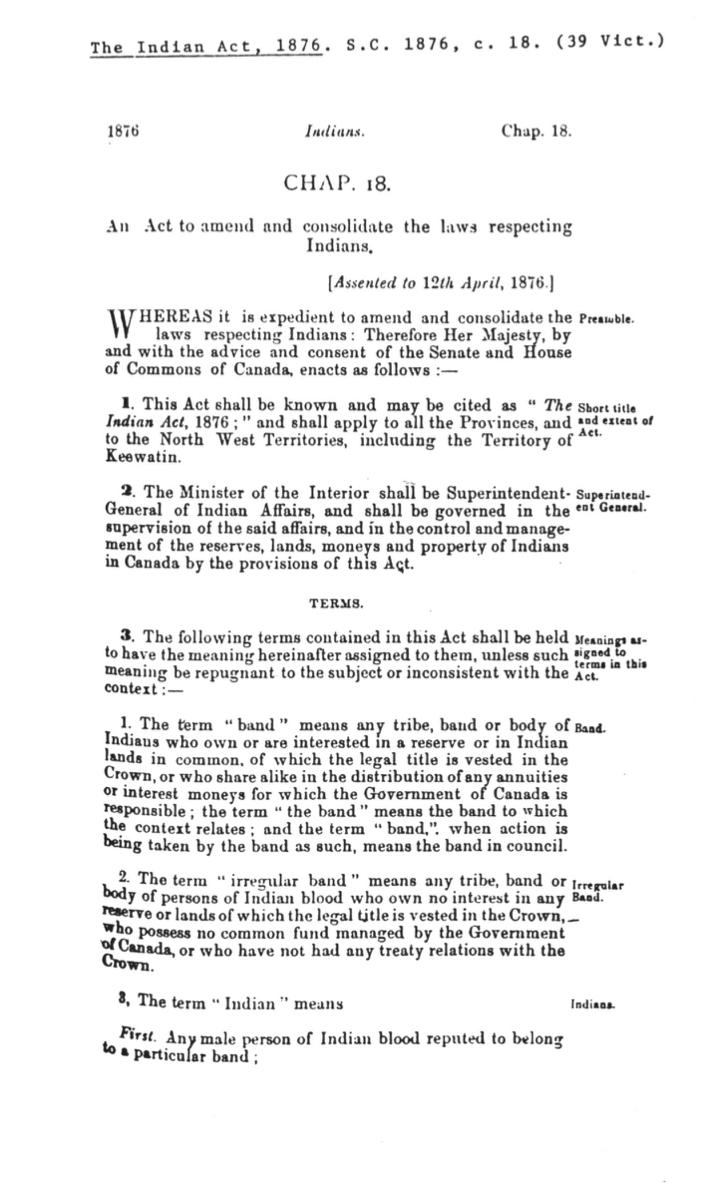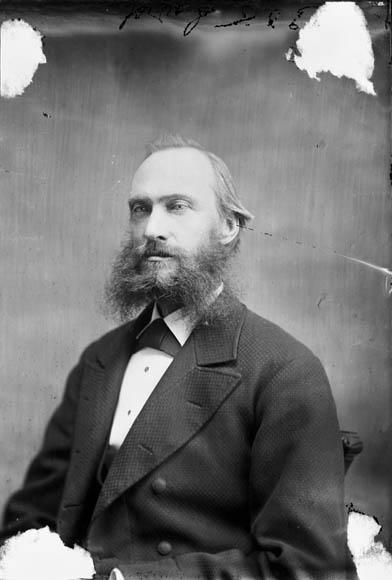The Indian Act
Canada’s segregation is legitimized in a new, far-reaching law
Date: 1876
In 1876, one of the most invasive and paternalistic Canadian laws was enacted in Ottawa. It dictated the lives of more than 100,000 people, telling them how to run their affairs, who to count as members of their communities, what cultural practices they could continue, and confined them to a fraction of the land they once lived on. In theory, it dangled an ultimatum: autonomy or assimilation. In reality, it delivered a policy that would later inform South African apartheid measures. Society was to be divided along racial lines — with long-lasting ramifications that still impact Canadian policy today.
What emerged as the Indian Act of 1876 bore little resemblance to colonial relations with Indigenous people a hundred years earlier. In the 18th century, different First Nations were regarded and treated as such: distinct nations, each a possible ally, as Britain worked to maintain their grasp on a continent with a plurality of Indigenous and non-Indigenous powers. Treaties with Indigenous communities were largely concerned with trade and maintaining peace; they were characterized by a rather hands-off philosophy. This attitude of non-interference and recognition of Aboriginal title to the land was confirmed in multiple seminal legal documents, including the 1760 Articles of Capitulation — when Britain effectively took over New France — and the Royal Proclamation of 1763.
Starting in the early 19th century, though, First Nations were seen less as allies and more as obstacles in the race to appropriate as much land as possible. Legislation such as the Gradual Civilization Act of 1857 and Gradual Enfranchisement Act of 1869 laid the groundwork for a national strategy to clear the hurdle toward acculturation and assimilation. Furthermore, the British North America Act of 1867, which outlined Canada’s self-governance, simultaneously dismantled any Indigenous self-governance. Under section 91(24) of the act, Ottawa now had jurisdiction over “Indians and Lands reserved for Indians.”
The Indian Act, which would be unveiled nine years later in 1876, built on top of these earlier policies. The singular law now classified hundreds of Indigenous nations and their members as one entity: the “Indian.” This guaranteed certain rights, from medical coverage and the ability to live on reserves to extended hunting seasons and fewer restrictions on the possession of firearms compared to non-Indigenous people.
But, as revealed by the Truth and Reconciliation Commission, these “rights” were rarely munificent, as reserves often sat on poorer quality land and medical “care” could mean harmful medical testing, administered without consent of the patient. If a status “Indian” wanted to participate in larger Canadian society, for instance, by living in the city, marrying someone who was not Indigenous, graduating from university or gaining the right to vote in a process called “enfranchisement,” their distinct status would be lost. This was a feature, not a bug, as far as the drafters of the legislation were concerned. “Indians must either be treated as minors or as white men,” Minister of the Interior David Laird said while introducing the act. For the government, the latter was preferable, ostensibly heralding a future where all former “Indians” had been subsumed into white settler society. In addition, the broad-sweeping policy didn’t treat all equally. Métis individuals were left out of the label, and the status of Indigenous women became entirely dependent on their male familial relations, from fathers to husbands.
The act alienated Indigenous people from their loved ones, as well as their land. “The impact of the Indian Act on the day-to-day life of Indigenous peoples was severe,” explained Johnny Mack, a Nuu-chah-nulth professor of law and Indigenous studies at the University of British Columbia. “It was relied on to force Indigenous peoples to give their children up to a residential school system, [and] the residential school system required that Indigenous children be taken from their communities and put somewhere else.”
Since 1876, the letter of the law has had its share of revisions. Amendments have included changes to the treatment of Indigenous women and the infamous potlatch ban, which was added in 1884 and then removed in 1951. Despite this, the current language is very similar to the original law. In a century plus of existence, it’s been both protested and fought for by different First Nations whose special status in Canada has been threatened and protected by the law. The Royal Commission on Aboriginal People called the act “the single most prominent reflection of the distinctive place of Indian peoples within the Canadian federation.” And yet, the commission noted, this distinction is not altogether a positive one. It is “marked by singular disparities in legal rights with Indian people subject to penalties and prohibitions that would have been ruled illegal and unconstitutional if they had been applied to anyone else in Canada.”
There have been movements to dismantle the problematic act — most notably in 1969 when Prime Minister Pierre Trudeau’s government released the White Paper, which recommended entirely eliminating Indian status and the Indian Act. The proposal was met with outrage by many First Nations, as leaders claimed it was but another attempt to erase Indigenous identity. Despite generations of trauma, segregation and violence that the act has inflicted on Indigenous people, the Indian Act remains in place.
Sources:
- Bélanger, Pierre, and Kate Yoon. Extraction Empire: Undermining the Systems, States and Scales of Canada’s Global Resource Empire. MIT Press, 2018.
- CBC News. "Aboriginal Children Used in Medical Tests, Commissioner Says." CBC, 31 July 2013, https://www.cbc.ca/news/politics/aboriginal-children-used-in-medical-tests-commissioner-says-1.1318150.
- Hanson, Erin. "The Indian Act." Indigenous Foundations, 5 May 2021, https://indigenousfoundations.arts.ubc.ca/the_indian_act/.
- Holmes, Joan. The Original Intentions of the Indian Act. Pacific Business and Law Institute, 17 Apr. 2002.
- Manuel, Arthur. Unsettling Canada. Between the Lines, 2015.
- Wilson, Kory. "The Indian Act." Pulling Together: A Guide for Indigenization of Post-Secondary Institutions, 5 Sept. 2018, https://opentextbc.ca/indigenizationfoundations/chapter/the-indian-act/.




![Officer: [Sir John A. Macdonald] Here, you copper colored gentlemen, no loafing allowed, you must either work or jump.](https://bc-timeline-backend.azureedge.net/sites/default/files/styles/gallery_resized/public/images/1-7_UNK_Copper%20Colored%20Gentlemen.png)

